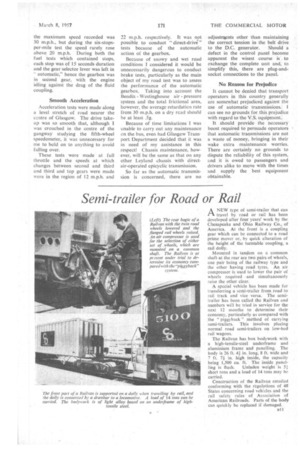Semi-trailer for Road or Rail
Page 45

If you've noticed an error in this article please click here to report it so we can fix it.
ANEW type of semi-trailer that can travel by road or rail has been developed after four years' work by the Chesapeake and Ohio Railway Co., of America. At the front is a coupling gear which can be connected to a road prime mover or, by quick alteration of the height of the turntable -coupling, a rail dolly.
Mounted in tandem on a common shaft at the rear are two pairs of wheels,
one pair being a the railway type and the other having road tyres. An air compressor is used to lower the pair of wheels required and simultaneously raise the other clear.
A special vehicle has been made for transferring a semi-trailer from road to rail track and vice versa. The semi trailer has been called the Railvan and numbers will be tried in service for the next 12 months to determine their economy, particularly as compared with the " piggyback" method of carrying semi-trailers. This involves placing normal road semi-trailers on low-bed rail wagons.
The Railvan has box bodywork with a high-tensile-steel underframe and aluminium, frame and panelling. The body is 26 ft. 41 in. long, 8 ft. wide and 7 ft. 7k in. high inside, the capacity being 1,500 Cu. ft. The inside panel ling is flush. Unladen weight is 51 short tons and a load of 14 tons may be carried.
Construction of the Railvan entailed. conforming with the regulations of 48
States concerning road vehicles and the rail safety rules of Association of American Railroads. Parts of the body can quickly be replaced if damaged.




































































































